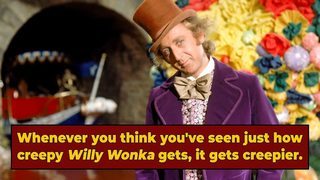'Willy Wonka's Original Draft Was Somehow Even More Insane

Roald Dahl's Charlie and the Chocolate Factory has been on my mind lately, and not just because it's been trending due to the "Sexy Willy Wonka" cosplayer who's become famous on TikTok:
Consider the story's premise -- Willy Wonka is a chocolate magnate who puts a golden ticket in five chocolate bars that he sends out into the world mixed in with his regular stuff. Wonka's promise is that whichever child finds a golden ticket gets to go on a special once in a lifetime tour of his factory, which has been closed off to the public. This is a global contest, seeing as his company is internationally famous, with products sent out all over the world, yet all the children who find the golden tickets are white. Well, except the ticket that was found in Japan ... that turned out to be forged, remember? (In the original movie, it was Paraguay, while in the Johnny Depp remake, it was Russia. Both to presumably make that storyline less racist.)
Don't Miss
That's ... kind of weird, right? I get that we probably shouldn't over-analyze a children's fantasy about the weird owner of a chocolate factory hurting kids for shits and giggles, but that just doesn't make sense. It would be mathematically impossible for all five winners of a global contest relying entirely on chance to be white as snow. It's even worse look if the only minorities we see are the Oompa Loompas dancing a jig as they roll the kids out the door.

The strangest thing about all this is that Roald Dahl apparently felt the same way because if he had it his way, Charlie himself would have been black. That's right, he had initially envisioned Charlie as a black British child, writing him as such in the original draft of the manuscript, titled "Charlie's Chocolate Boy." And though this Charlie wouldn't inherit his fortune (because Willy Wonka is married and has a son in this version), the story does end with Willy Wonka gifting him his own chocolate store.
It's a nice ending, but it's how he gets there that's a bit disconcerting. According to a description of the original draft:
"So Charlie ends up in the Easter Room, where there are life-size candy molds of creatures, and one of these life-size molds is shaped like a chocolate boy ..."
Okay, I'm with it so far ...
"Charlie is fascinated by this. Wonka helps him into the mold and gets distracted ..."
Typical Willy Wonka, that negligent rascal, still enjoying it though ...
"The mold closes, and the chocolate pours over his body and he is suffocating and nearly drowning in it. And it hardens around him, which feels terrible. He's trapped."
Okay, a bit of a red flag, can see where this is going, but I hope Roald Dahl doesn't take it there ...
"He's alive but can't be seen or heard. No one knows where he's gone. Then he gets taken to Wonka's house to be the chocolate boy in Wonka's son's Easter basket."

Aaaand there it is. The black kid gets frozen into a smiling brown chocolate figurine and literally served to Willy Wonka's son.
Honestly, trying to figure out how progressive this version of the novel actually would have been is kind of an emotional rollercoaster, considering it also had the Oompa Loompas be a tribe of African pygmies. Yes, his happy slaves are literally "happy slaves." But is this really that surprising coming from a man as anti-Semitic as Roald Dahl? No wonder his attempts at sprinkling diversity into the manuscript ended so badly.
Pains me to say this, but if forced to choose between both versions, maybe the super white yet overall less offensive version of Charlie and the Chocolate Factory really is the better call, even with the vague pedophilia.
Archie actually thinks the next Charlie and the Chocolate Factory remake should have a black actor cast as Charlie like Roald Dahl wanted, but definitely cut out all that other stuff. You can chat with her about it on Twitter or her website.
Top image: Paramount Pictures